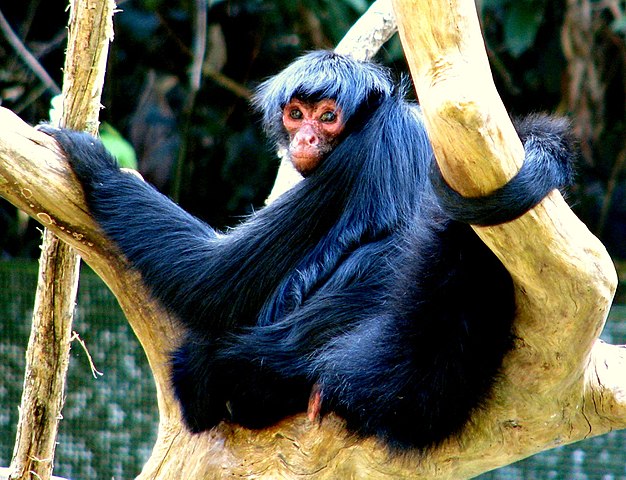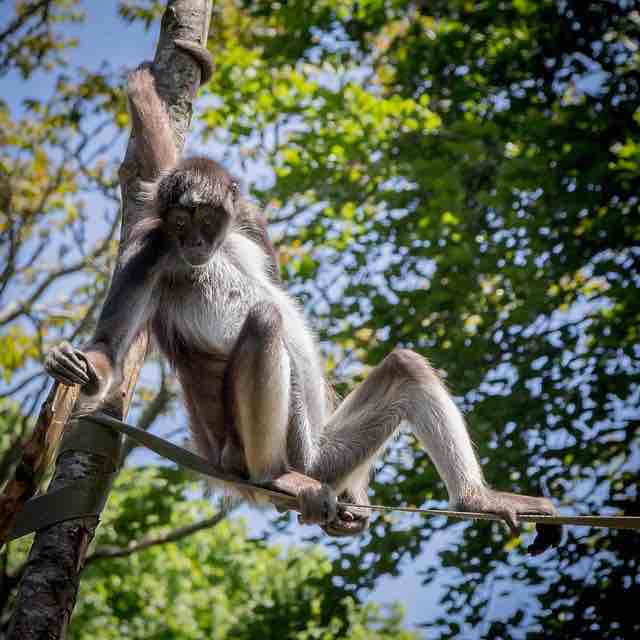
Scientific name, species, characteristics, where does it live? Feeding, reproduction, baby spider monkey, endangered?
The spider monkey (Ateles spp.) is one of the four genera of non-human primates of the Neotropics that is widely distributed in the tropical and deciduous forests of South and Central America. It is found from sea level to 1,800 meters above sea level (Guzmán Serrano et al., 2008; Reid, 2009).
The Ateles genus belongs to the Atelinae subfamily, which is characterized by arboreal primates with long limbs and great agility, and having a long prehensile tail that they use to support their body while they feed or as additional support during locomotion (Di Fiore and Campbell, 2007).
Scientific name of the Spider Monkey
They belong to the family Atelidae, the superfamily Ceboidea, the infraorder Platyrrhine, the suborder Anthropoidea, and the order Primates (Bruner and Cucina, 2005).
- Class: Mammalia
- Order:Primates
- Family: Atelidae
- Genus: Ateles
- Species: Ateles geoffroyi
Common names: Spider monkey, long-handed monkey, and white-bellied monkey
Etymology
The genus Ateles from the Greek “incomplete,” is an allusion to the fact that the species that make up this genus lack a thumb on their front extremities, and the specific epithet fusciceps comes from the Latin terms fuscus and ceps, or “dark head” (Tirira, 2004 ).

CCbySA2.0
Characteristics of the Ateles
It is a species of wild primate that stands out among the largest Neotropical primates, measuring between 35 and 45 cm in height and its tail can reach 85 cm (Ramos, 2006). However, they have a finer appearance than other monkeys.
The body is thick with thin, very long limbs. Its head is relatively small and it has a prehensile tail whose end is bare at the bottom and which they use as a fifth limb to move agilely among the trees. They have four fingers and no thumb.
Adult animals can weigh up to 9 or 10 kg (Guzmán Serrano et al., 2008; Reid, 2009).
Most individuals have pinkish skin around the eyes and mouth; the color of the different species varies from light brown to black. On the back it has a dark coloration, and in the abdominal region it has a lighter color (explaining why it is called white-bellied monkey), in addition to presenting a kind of tuft on the top of the head (Serio-Silva et al., 2006) .
Males and females are about the same size. Males lack a beard, and females can be distinguished by their particularly long, pendulum-shaped clitoris, while the genitalia of males are usually hidden (Van Roosmalen and Klein, 1998; Guzmán Serrano et al., 2008; Reid, 2009).
Where does the Spider Monkey live?
They typically inhabit tropical forests and jungles from southeastern Mexico to the south of the Amazon River basin (Morales, 2003), and in terrains of various elevations, ranging from sea level to a little over 2,500 meters above sea level.
The spider monkey prefers undisturbed tropical forests and can be found in riparian vegetation, although it is mostly seen in the upper levels of the forest (Van Roosmalen and Klein, 1988).
Of the four species recognized for the genus Ateles, only the black-handed spider monkey (A. geoffroyi) inhabits the humid tropical forests of Mexico (Collins, 2008).

Petruss / CC BY-SA
Feeding of the Ateles
It is a herbivorous and frugivorous primate species (Russo et al., 2005). Their diet is based on the consumption of fleshy fruits, which constitute about 80-90% of their daily diet; the rest is provided by leaves (Di Fiore and Campbell, 2007); however, they can also consume nuts, bird eggs, insects, spiders, tree bark and honey.
It is important to mention that spider monkeys play a vital role in maintaining diversity in their habitat as seed dispersers; thanks to their consumption of fruits, they return the seeds to the soil when they are excreted, after which the seeds can germinate (Link et al. DiFiore, 2005).
Spider Monkey Reproduction
They reach sexual maturity at 4 or 5 years of age, and can live up to 20 years. The females have a fairly large clitoris, which can make it difficult to distinguish them from the males. However, males have no problem recognizing them, and after courtship they choose a mate from the group.
Gestation comprises a period between 226 and 232 days, and later the delivery of a single young occurs. The mother is responsible for the care of her little one, whom she feeds with breast milk for a period of 18 to 20 months when in captivity, or 23 to 36 months in the wild. There is a very close relationship between mothers and children, and they are practically inseparable until one year of age (Chapman and Chapman, 1990). The interval between births is approximately 3 to 4 years.

Behavior
They are inhabitants of the forest canopy and live in social groups (Muñoz et al., 2006; Di Fiore and Campbell, 2007). It is known that these primates enjoy heights and are known for a lifestyle where they prefer to carry out activities in the trees, as their limbs help them to balance between branches and vines more easily (Cambpell et al., 2005).
They are characterized by a quite varied social structure, since within the group in which they live there are several males and several females, contrary to other primates where only one male can exist within a group (Ahumada, 1992).
The spider monkey community forms temporary groups of different sizes and composition throughout the day, and can change subgroups several times during the day (Ramos, 2006).

Males tend to interact more with each other and show greater aggressiveness towards females, and females tend to be more solitary and less active than males within the group (Ferdigan and Baxter, 1984).
This species also presents behavioral differences between females with and without young that are based on the patterns of similar behaviors directed from mothers to children. Females without young are more solitary than mothers, and they are more active and present more foraging behaviors, locomotion, vocalization, play, and branch sniffing (Fedigan and Baxter, 1984).
Species conservation status
Spider monkeys are one of the neotropical mammals most vulnerable to habitat degradation and fragmentation, as well as to hunting (Michalski and Peres, 2005).
The problem intensifies because the belief among the indigenous tribes is that the meat of these animals is of good quality, so hunting them is a common practice (see: Typical Amazon Dishes).
Deforestation processes to facilitate the production of exportable products such as fruits, vegetables, and ornamental plants, among others, coupled with uncontrollable urbanization, make the forest shrink every day.
This causes the displacement of these animals to unsuitable places that lack trees of the desired height for spider monkeys.
Is the Spider Monkey in danger of extinction?
According to the above, all the species of this genus have been categorized as endangered (EN) or critically endangered (CR) (Cuarón et al. 2008; Dirzo et al., 2013).
Likewise, the recovery of their populations is difficult due to the intrinsic characteristics of the Ateles genus, such as a relatively low reproductive rate, with an interval between births of 3 to 4 years (Shimoka et al., 2008, Tirira, 2004).

Biólogo – Universidad de Oriente – núcleo de Sucre. Venezuela (2013). Profesora de Biología hasta el 2018 de la Universidad de Oriente – núcleo Bolivar. Certificada en gestión de calidad e inocuidad alimentaria ISO 22000 y gestión de la calidad en laboratorios ISO 17025. Actualmente vive en Ecuador. Senescyt Nro. 8622122546
Bibliography
- Ahumada., J. (1992). Grooming behavior of spider monkeys (Ateles geoffroyi) on Barro Colorado Island, Panama. International Journal of Primatology, 13 (1), 33- 49. PDF
- Bruner E, Cucina A (2005) Alouatta, Aletes and the ancient Mesoamerican cultures. Journal of Anthropological Sciences, vol. 83: 111-117. PDF
- Chapman, C. A. y L. J. Chapman. 1990. Reproductive biology of captive and free-ranging spider monkeys. Zoological biology, 9: 1-9. Source
- Campbell, C.J., Aureli, F., Chapman, C.A., Ramos-Fernández, G., Matthews, K., Russo, S.E., Suarez, S. & Vick, L. (2005). Terrestrial behavior of Ateles spp. International Journal of Primatology, 26 (5), 1039–1051. Source
- Collins A (2008) The taxonomy status of spider monkeys in the twenty-first century. In: Campbell CJ (Ed) Spider Monkeys: Behavior, Ecology and Evolution of the Genus Ateles. Cambridge University Press, 50-78. PDF
- Cuarón, A. D., A. Morales, A. Shedden, E. Rodriguez-Luna, y P. C. de Grammont. 2008. Ateles geoffroyi ssp. vellerosus, in IUCN 2010. IUCN Red List of Threatened Species. Version 2010.4. Disponible en: www.iucnredlist.org Bajado el 11 February 2011. Source
- Di Fiore, A. y C., Campbell. 2007. The atelines: variation in ecology, behavior, and social organization. p.155-185. In: C. J. Campbell, A. Fuentes, K. C. MacKinnon, M. Source
- Panger y S. K. Bearder, editors. Primates in perspective Oxford University Press, Nueva York. 5. Fedigan, L. M. y M., Baxter. 1984. Sex differences and social organization in free-ranging spider monkeys (Ateles geoffroyi). Primates, 25: 279-294. PDF
- Dirzo R, Young HS, Galetti M, Ceballos G, Isaac NJB, Collen B (2014) Defaunation in the Anthropocene. Science (80-) 345:401–406 Fuente
- Fedigan, L. M. y M., Baxter. 1984. Sex differences and social organization in free-ranging spider monkeys (Ateles geoffroyi). Primates, 25: 279-294. Source
- Guzmán Serrano, V., Henríquez, S., Rodríguez, M. & Lara, K.(2008). Mamíferos de El Salvador: Fichas técnicas. Fundación Zoológica de El Salvador (FUNZEL) – Universidad de El Salva-dor (UES /Escuela de Biología), San Salvador. 299 p PDF
- Link A & Fiore A. 2006. Seed dispersal by spider monkeys and its importance in the maintenance of neotropical rain-forest diversity. Journal of Tropical Ecology 22: 235-246. PDF
- MICHALSKI F, PERES CA. Anthropogenic determinants of primate and carnivore local extinctions in a fragmented forest landscape of southern Amazonia. Biol Conserv. 2005; 124:383–396. Source
- Morales H. K. 2003. Estudio preliminar de la población de Ateles geoffroyi “mono araña” en Chaguantique y El Tercio, departamento de Usulután, El Salvador. Título de Licenciatura. Universidad de El Salvador. 10p. PDF
- Muñoz,D.,A.Estrada,E.NaranjoyS.Ochoa.2006.ForagingEcologyofHowlerMonkeysinacacao(Theobromacacao)PlantationinComacalco,Mexico.AmericanJournalofPrimatology,68:127-142 Fuente
- Ramos, H. 2006. Modelos estadísticos de forrajeo en un medio desordenado. Una descripción de las trayectorias recorridas por los primates al alimentarse. Master’s Thesis. Posgrado en Ciencias Físicas. Universidad Nacional Autónoma de México. 69 p. Source
- Reid, F. (2009). A field guide to the mammals of Central America and Southeast México. Oxford University Press, 2a ed. 384 p PDF
- Russo S. E., C. J. Campbell, J. L. Dew, P. R. Stevenson y S. Suarez. 2005. A multi-forest comparison of dietary preferences and seed dispersal by Ateles spp. International Journal of Primatology. 26 (5):1017-1037. PDF
- Serio-Silva, J. C., Rico-Gray, V. & Ramos-Fernández, G. (2006). Mapping Primate Populations in the Yucatan Peninsula, Mexico: A first Assessment. Pp. 489-511. In: Estrada, A. Garber, P. A., Pavelka, M. & Leucke, L. (Eds.). News Perspectives in the Studies of Mesoamerican Primates: Distribution, Ecology, Behavior and Conservation. Springer. New York, E.U.A. Fuente
- Shimooka, Y., C. J. Campbell, A. Di Fiore, A. M. Felton, K. Izawa, A. Link, A. Nishimura, G.Ramos-Fernández, y R. B. Wallace. 2008. Demography and group composition of Ateles. Pp. 329-348 in Spider monkeys: behavior, ecology and evolution of the genus Ateles (Campbell, C. J. Ed.). Cambridge University Press. Cambridge, United Kingdom. Source
- Tirira, D. G. 2004. Nombres de los Mamíferos del Ecuador. Ediciones Murciélago Blanco y Museo Ecuatoriano de Ciencias Naturales. Publicación Especial de los Mamíferos del Ecuador 5. Quito. PDF
- Van Roosmalen M.G. M. y L. L. Klein. 1988. The spider monkeys, genus Ateles. En: Mittermeier, R. A., A.B. ,Rylands; A. F., Coimbra-Filho y G. A. B. da Fonseca. Editores. Ecology and behavior of neotropical primates, Vol. 2. Washington, D.C. World Wildlife Fund. 455-575p. PDF
- Wildscreen Arkive 2015. Black spider monkey. http://www.arkive.org/black-spider-monkey/ateles-paniscus Source
This post is also available in:
![]() Español (Spanish)
Español (Spanish)
